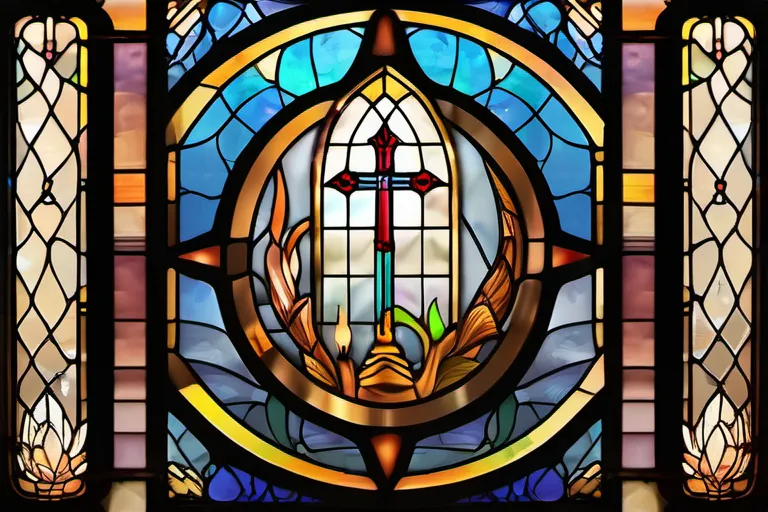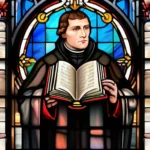Explore the history, beliefs, and denominations of Protestantism in this detailed article.
Protestantism is a major branch of Christianity that originated during the 16th century. This article provides an in-depth look at the history, beliefs, and denominations of Protestantism. Let’s dive into the fascinating world of Protestant religion!
The Origins of Protestantism
Imagine stepping back into the tumultuous 16th century, when Europe was on the brink of a seismic shift that would redefine religious and social life for centuries to come. How did it all begin? What sparked this revolution in faith? The origins of Protestantism can be traced back to a single act of defiance by a young professor at a German university.
Our story starts with Martin Luther, who nailed his 95 theses to the door of All Saints’ Church in Wittenberg on October 31, 1517. This bold act was like throwing a pebble into a still pond; it caused ripples that would spread across Europe and beyond. But why did Luther decide to challenge the Church? He saw an opportunity to address what he perceived as corruption within the Catholic Church, such as the sale of indulgences.
It’s almost as if Luther was shouting from the rooftops, ‘Why should we pay for our salvation when God alone can grant it?’ This idea that salvation comes through faith in Jesus Christ, not good works or church rituals, was revolutionary. It marked a turning point, like a fork in the road, where one path led to continued tradition and another to a fresh approach based on scripture.
John Calvin, later known as the father of Reformed Protestantism, added his voice to this chorus. His teachings emphasized the sovereignty of God, predestination, and the idea that believers have a duty to govern their lives according to moral principles derived from Scripture. His work, ‘Institutes of the Christian Religion,’ became one of the foundational texts for many Protestant denominations.
These men were not just thinkers; they were revolutionaries who changed the course of history. Their ideas spread like wildfire through pamphlets and books, reaching even those far beyond the borders of their homeland. It’s almost as if a new religion was being born right before everyone’s eyes, challenging old beliefs and ushering in a new era.
The Reformation led to the establishment of various Protestant denominations, each with its own unique take on theology and practice. Some focused more on the individual’s relationship with God, while others emphasized community service and social justice. It was truly like planting seeds in different soils, and each one grew into a distinct flower, enriching the garden of Christianity.
So, as we look back at these early days of Protestantism, it’s clear that what began as a small act of defiance grew into something much larger – a movement that transformed not only religious practices but also the very fabric of society. It was a time when old certainties were questioned and new ones sought, setting the stage for the diverse landscape of Protestant Christianity we see today.
Protestant Beliefs and Doctrines
When we talk about Protestantism, one of the key beliefs that often comes to mind is ‘justification by faith alone.’ But what does this really mean? Is it just a catchy phrase, or does it hold deeper significance in understanding how Protestants view salvation?
This belief can be likened to a lighthouse guiding ships through treacherous waters. Just as a lighthouse illuminates the path to safety, justification by faith alone offers believers a clear and direct route to God’s grace. It suggests that our relationship with God is not based on our own deeds or works but solely on our faith in Christ.
But how does this belief shape other aspects of Protestant thought? The idea that everyone has the right and ability to communicate directly with God, known as the ‘priesthood of all believers,’ is a natural extension. This means that every Christian can approach God without the need for intermediaries like priests or religious leaders. It’s akin to saying everyone can reach the top of a mountain on their own without the need for a guide.
The authority of Scripture as the ultimate source of truth and guidance is another cornerstone of Protestant belief. Imagine if you had a rulebook that not only outlined your responsibilities but also offered profound wisdom for life. That’s what Protestants see in the Bible, viewing it as both authoritative and accessible.
All these beliefs interlock like pieces of a puzzle, creating a coherent framework for understanding how Protestants approach faith, church governance, and personal morality. Justification by faith alone, the priesthood of all believers, and the authority of Scripture are not just abstract concepts but practical guidelines that shape daily lives and communal practices.
So, as we delve deeper into these beliefs, remember: they’re more than just words—they’re a map to navigate the complexities of faith in the modern world. How do you see these beliefs influencing your own spiritual journey?
Protestant Denominations
Now that we’ve explored the core beliefs of Protestantism, let’s dive into its diverse denominations and see how they carve their unique paths within this vast religious landscape. Imagine each denomination as a branch on the tree of Christianity, each one bearing its own fruit, yet all rooted in the same trunk.
Lutheranism is like a sturdy oak, deeply anchored in the teachings of Martin Luther. This denomination emphasizes justification by faith and the importance of scripture, much like how an oak relies on its deep roots to weather storms. Its rituals and practices are often grounded in tradition, providing stability during times of change.
Calvinism, on the other hand, is more akin to a precision-engineered clock, ticking away with its doctrines of predestination and the sovereignty of God. John Calvin’s ideas have shaped this denomination into a rigorous system where every aspect of worship and belief is finely calibrated. It’s no wonder that Calvinists often find their lives structured around these principles, seeking clarity in an uncertain world.
Anglicanism stands out as a bridge between Protestantism and Catholicism, much like a river flowing gently through both plains and mountains. This denomination retains many of the liturgical practices of the Roman Catholic Church but is deeply influenced by Reformation principles. Its bishops and traditions blend the best of both worlds, creating a unique form of worship that resonates with many.
Methodism, finally, can be likened to a bustling highway, filled with travelers on various journeys. John Wesley’s emphasis on personal holiness and social justice has made Methodism a dynamic movement that adapts easily to different cultural contexts. Its open-door policy means anyone is welcome, making it one of the fastest-growing denominations globally.
Each of these Protestant branches offers a unique perspective on faith, much like how different lenses in a camera capture light differently. Whether you find solace in the steadfast oak of Lutheranism, the precise ticks of Calvinism, the flowing streams of Anglicanism, or the vibrant traffic of Methodism, there’s something for everyone in this rich tapestry of beliefs and practices.
The Spread of Protestantism
The spread of Protestantism across Europe, North America, and beyond can be likened to a river flowing from its source into vast oceans. Initially, this movement began in Germany, where Martin Luther’s challenge against the Catholic Church sparked a revolution that would change the religious landscape forever. How could one single man’s actions set off such seismic shifts? The impact of his 95 Theses on the Church echoed like distant thunder across Europe, eventually rippling into other continents.
As Protestantism spread to Northern and Eastern Europe, it encountered different cultural landscapes. In countries like Scandinavia, the transformation was marked by a strong embrace of Lutheran teachings, leading to reforms that reshaped social structures and governance. Meanwhile, in Eastern Europe, the impact was more muted but significant, with Calvinist influences finding fertile ground among the nobility.
In North America, the story unfolds through a series of migrations and conflicts. The Puritans, seeking religious freedom, brought their brand of Protestantism to the New World, establishing colonies where religious practices like predestination were deeply embedded in daily life. Over time, this area saw the emergence of various denominations such as Baptists, Presbyterians, and Congregationalists, each with its own unique beliefs and practices.
The journey of Protestantism beyond Europe is a testament to its adaptability. It found homes in Africa, where it blended with local traditions, and in the global South, where evangelical movements flourished among growing populations. These new frontiers not only expanded the geographical reach but also enriched the religious tapestry, creating diverse interpretations of Protestantism that reflect local cultures.
The spread of Protestantism has been a dynamic process, influencing societies through education, social reforms, and political changes. It’s as if each region it entered was a blank canvas upon which new hues were painted—sometimes vibrant, sometimes muted, but always adding to the rich mosaic of global religious life. How did these diverse contexts shape the faith, and in turn, how did Protestantism adapt to meet the unique needs of its followers?
Protestantism Today
Today, Protestantism faces a myriad of challenges that test its resilience and adaptability. One of the most pressing issues is the steady decline in membership numbers across many denominations. Why are these churches losing their faithful followers? Is it simply a generational shift or does it stem from deeper theological or social issues within the faith?
The role of women in Protestant leadership has also become a focal point for many congregations. Historically, Protestantism was one of the first religions to challenge traditional gender roles, allowing women to minister and preach. However, today, this progress is under scrutiny as some conservative denominations push back against women’s ordination. How does the church navigate these conflicting views without alienating its core values?
The intersection of faith and politics is another complex issue facing Protestant churches. In an era where political polarization is rampant, how do religious leaders maintain their neutrality while still advocating for their moral stances? The line between personal convictions and public policy can be blurred, leading to internal conflicts within the church community. Can a balance be struck that honors both faith and civic engagement?
These contemporary issues are not just surface-level problems; they delve into the very core of what it means to be Protestant in today’s world. As we ponder these challenges, one thing is clear: Protestantism continues to evolve, much like the societies it serves. The future of this dynamic faith depends on how it responds to these pressing questions and whether it can find common ground between tradition and modernity.
As we look forward, the answers to these questions will shape not only the future of individual churches but also the broader narrative of Protestantism in a rapidly changing world. Will it remain a force for social change or adapt to become more inward-focused? The path ahead is fraught with uncertainties, yet it holds the potential for profound transformation.
The Legacy of Protestantism
How has Protestantism left its indelible mark on Western civilization? One might wonder if the Protestant Ethic and Economic Spirit were merely passing fads or if they have shaped the very fabric of our society. From the Enlightenment‘s pursuit of reason to the abolitionist movements, Protestants have been at the forefront of some of history’s most significant transformations.
Consider the realm of art and literature: How can we fully appreciate the works of Rembrandt or John Milton without understanding their Protestant roots? The Dutch Reformation, which inspired artists to explore human emotions in detail, paved the way for a new era of realism and introspection. In literature, the Bible became a source of profound inspiration, influencing writers like The Pilgrim’s Progress‘s John Bunyan and Crime and Punishment‘s Fyodor Dostoevsky.
Moving on to music, it would be a mistake not to recognize the immense contributions of Protestant hymnody. The Hymnal, with its rich melodies and emotional depth, has permeated both religious and secular life. Think about how a simple tune like ‘Amazing Grace’ can stir the soul, a testament to the power of spiritual expression.
In terms of education, the Protestant emphasis on literacy and critical thinking cannot be overstated. The Wesleyan Method, for instance, encouraged not only religious but also intellectual growth, leading to the establishment of many educational institutions that still thrive today. This approach has fostered a culture where knowledge is valued not just for its own sake, but as a means to serve others and understand the world more deeply.
Finally, let us reflect on how Protestantism’s emphasis on individual responsibility and moral autonomy laid the groundwork for modern democracy and human rights. From Martin Luther King Jr.’s civil rights movement to contemporary activism, Protestants have been advocates for justice and equality, demonstrating that their legacy extends far beyond their churches.
In sum, Protestantism has woven itself into the very tapestry of Western civilization, influencing not just religious practices but also cultural, social, and political spheres. As we continue to grapple with today’s challenges, it is essential to recognize this rich heritage and its enduring impact on our world.
Conclusion
 In conclusion, Protestantism has played a significant role in shaping Western culture and continues to be a vibrant part of global Christianity today. Understanding its history, beliefs, and denominations can provide valuable insights into this important religious tradition.
In conclusion, Protestantism has played a significant role in shaping Western culture and continues to be a vibrant part of global Christianity today. Understanding its history, beliefs, and denominations can provide valuable insights into this important religious tradition.











